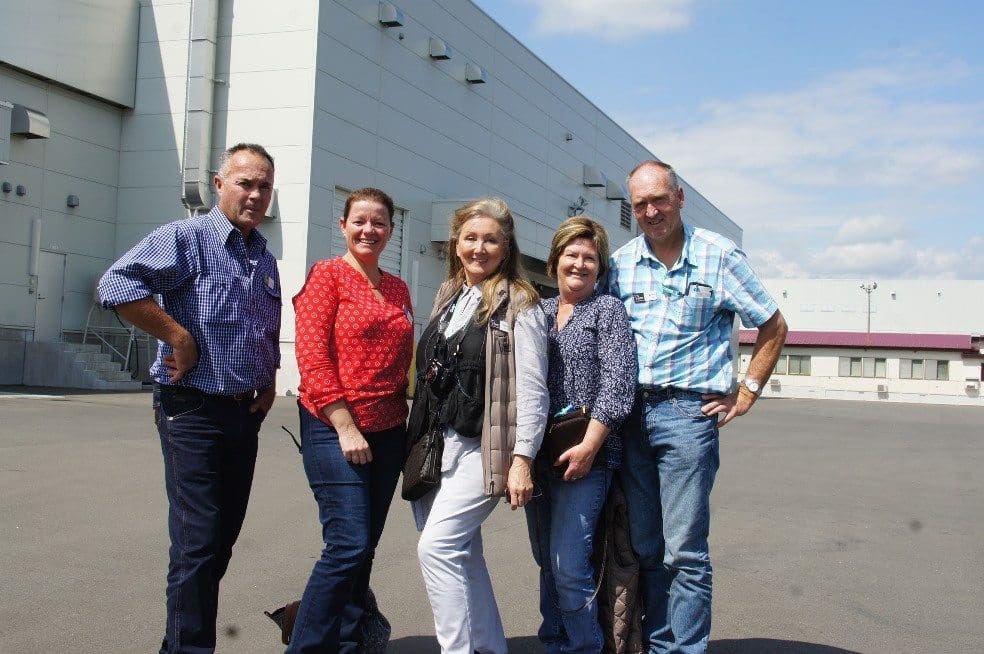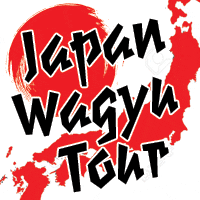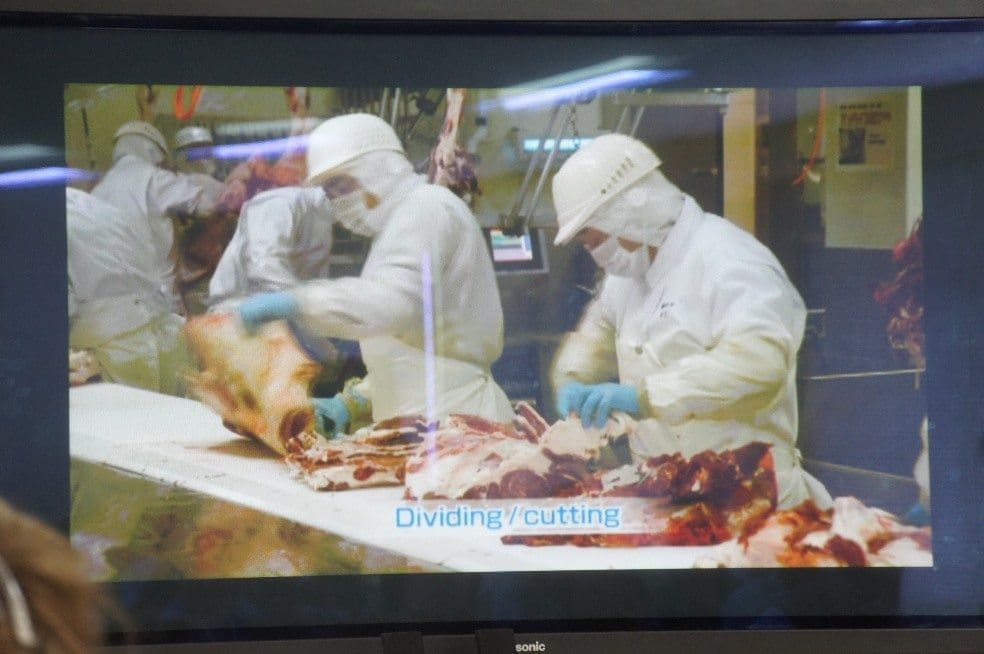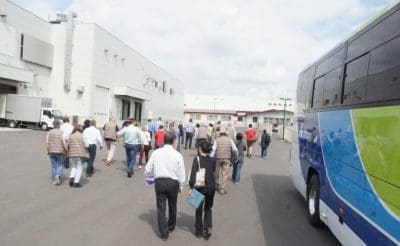
NSW tour members Grant and Lissanne Spackmann from Glen Davis; Patricia Bourke from Ourimbah; and Kevin and Leanne Eakin from Cundleton, at the Hokkaido processing plant yesterday. Click on image for a larger view.
WHILE Japan’s single largest beef processing plant may be modest in size compared with many in Australia, what it lacks in scale it makes up for in attention to detail, precision and heavy focus on traceability and food safety.
Hokkaido Livestock Corporation is a service kill facility on Japan’s northernmost island of Hokkaido, processing around 400 head per day.
 The business is owned jointly by the prefectural government and a number of agricultural farmer cooperatives, processing cattle on contract for a dozen or more regular customers, mostly co-ops or wholesalers.
The business is owned jointly by the prefectural government and a number of agricultural farmer cooperatives, processing cattle on contract for a dozen or more regular customers, mostly co-ops or wholesalers.
The Australian Wagyu Association/Quadrant Japan Wagyu tour group had a guided tour through the impressive facility yesterday.
Given Hokkaido is the centre of Japan’s large dairy industry, it was no surprise to learn that cull dairy cows make up about 30pc of the plant’s throughput, with another 50pc fed Holstein steers, and the remaining 20pc Wagyu – either Holstein crosses or Fullbloods.
Average carcase size passing through the plant is very large, by Australian standards. Fed Holsteins averaging 420kg carcase weight at 20 months of age, and the Wagyu component 480kg at 28 months. In comparison, average carcase weight across all domestic-to-export beef kills in Australia is about 290kg.
Factoring-in that large carcase size, the HLC plant’s beef output of 400 head per day is considerably larger than it appears.
Because of their sheer mass, Wagyu carcases are chilled for two days before grading and boning, with Holsteins normally day after slaughter.
Dressing percentages on both dairy steer and Wagyu are around 58pc, with carcase-to-meat yield around 65pc on the dairy steer, and 67pc on the Wagyu, on account of their moderate bone.
The tour group hosts said carcase yield was difficult to quantify, because every service kill customer using the plant’s services had their own prescribed cutting lines, which the boners had to adapt to.
Traceability key feature
Traceability is a key feature of operations, with individual animal and property of origin retained right through to the carton. The challenge in providing separation in a busy boning room and packing area is provided through a series of five metal ‘tags’ which stay with the carcase pieces as they are broken down. The carcase’s original bar code number is electronically assigned to each set of numbered metal tags, through to labels attached to each vacuum-packed primal in the box.
Some Japanese supermarkets indicate the individual animal ID and farm of origin on retail beef packs in their stores, accessible via QR codes scannable on a mobile phone.
Food safety big consideration
The HLC facility in Hokkaido applies a rigid set of protocols for food safety and hygiene, ranging from high-frequency sterilisation of hand-tools and equipment, anti-microbial carcase washes, personal hygiene through protective clothing, air showers and hand-held ‘vacuums’ for clothing.
As a result, shelf life on vac-pack chilled product was typically about 50 days.
Layered on top of that are two specific rapid-turnaround laboratory tests for BSE and the radioactive metal, caesium (introduced as a result of eastern Japan’s 2011 Tsunami and nuclear power station disaster).
A decade and a half after Japan’s isolated cases of BSE, every single carcase is still tested, by law, for BSE. The considerable cost is shared between government and the owner of the cattle at slaughter. Despite the relentless testing, no further BSE cases have been found, but the perseverance with testing provided a level of ‘confidence’ for Japanese consumers, Beef Central was told yesterday.
Like all the 130 meat plants in Japan, the Hokkaido facility visited yesterday carries out an elaborate procedure to remove specified risk materials (SRM’s – effectively nervous system materials like spinal cord) to further negate any BSE risk. All SRM material is incinerated at extreme temperatures, sufficient to destroy BSE prions.
The overall business employs about 300 staff in total, with a boning room team of about 60. Rendering is carried out at a separate, remote site.
The tour group asked about the cost charged to service kill customers to get a beast slaughtered, boned and packed. The response was 14,000 Yen (around A$160) including grading fee – an unusually low figure, which may have been lost in translation, in Beef Central’s opinion. The same cost in Australia is more like $300.
Surgical precision in boning
The Wagyu tour group had the chance to observe the plant’s boning room in operation from an adjacent viewing room. Unfortunately no photos were permitted inside the plant, but we managed to capture these rough images from a short corporate video.

The first feature that was apparent was the sheer size of beef sides being boned, and the rib eyes, knuckles and topsides being harvested from each body.
The second was the attention to detail in knifework, with the emphasis squarely on maximising boning room yield from each carcase, rather than speed. Bone and red meat were being separated with surgical precision – as it needs to be with high-value product like this.
With Fullblood Wagyu carcases worth up to 3000 Yen per kilogram (about A$20,000 per carcase) a 1pc boning room yield improvement can add up to big bucks, across a day’s kill.
In a development familiar to the processing industry in Australia, the HLC plant a year ago underwent a major expansion and upgrade, absorbing the kill previously carried out at a second, smaller, more dated company abattoir some 200km away, which has since closed.
As the photos show, the infrastructure for a plant of this size is colossal, by Australian standards. The construction cost for the expansion was said to be some ten billion yen, or A$114 million.
- More Wagyu tour reports in coming days
- Access earlier Wagyu tour stories via links below.

Arriving at the Hokkaido processing facility yesterday
